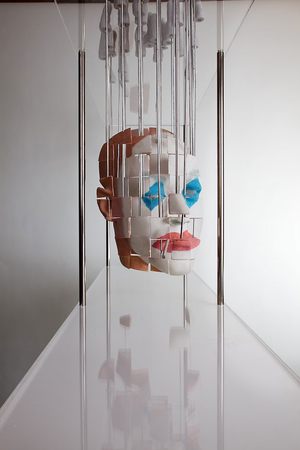This has been a fascinating project to complete from research to execution. At the beginning, it was hard to choose a topic to focus on since there were many facets of Asian art that that we learned during the semester. We decided to go for Buddhism in the end because we were all drawn to do a piece about it. At first, our goal was just to challenge the image of the Buddha icon by mashing it with pop iconography. A commentary on how interesting it is that his features
changed in different contexts to be adapted for local worship. We thought about even more and came to the conclusion that if a deity looks like you or someone who could exist in one’s culture, it is easier to relate to the icon and worship. Hence, we tie it in with our piece and modernise the context. This discusses another type of worship, ‘celebrity worship’.
After doing our research, we discovered the brilliance of Gyatso Gonkar’s work. He is a Tibetan artist who takes Buddhist iconography and mixes it with pop culture as well. However, his work focuses on materialism and consumerism.
When we finally got a focus for our work, Dissecting an Icon, we wanted to push the idea of dissection further. Leon came across Jonty Hurwitz, an artist who specialises in nano sculpture and visual illusions. His work, The Thinker, deeply inspired our piece.
A piece that is only whole in one angle and pulled apart in all the others. We think that it gives depth to the piece and a reminder that icons could have diverse meanings from different perspectives.
Bibliography
Behrendt, Kurt. “Tibetan Buddhist Art In The Twenty-First Century”. The Metropolitan Museum Of Art, I.E. The Met Museum, 2016. http://www.metmuseum.org/blogs/now-at-the-met/2014/ tibetan-buddhist-art.
Coomaraswamy, Ananda K. “The Origin of the Buddha Image.” The Art Bulletin 9, no. 4 (1927): 287-328.
Cribb, Joe. “The origin of the Buddha image—the numismatic evidence.” South Asian Archaeology (1981): 231-44. http://www.thlib.org/static/reprints/jts/JTS_07_02.pdf
Exotic India Art. Evolution of the Buddha Image. May, 2004. http://www.exoticindiaart.com/article/ lordbuddha/ (accessed April 5, 2016)
Gyatso, Gunkar. Ambivalent Resolution. Stickers, paper collage, pencil, marker, polyurethane finish on resin sculpture. New York: Sotheby’s, 2016.
Gyatso, Gonkar. Dissected Buddha. Collage, stickers, pencil and colored pencil, and acrylic on paper. New York: The Metropolitan City of Art, 2016.
Gyatso, Gonkar. Three Realms. Collage, stickers, pencil and colored pencil, and acrylic on paper. New York: The Metropolitan City of Art, 2016.
Hurwitz, Jonty. “Funny”. Art Of Jonty Hurwitz, 2015. http://www.jontyhurwitz.com/funny.
Hurwitz, Jonty. The Thinker. Resin, powder, steel and perspex. London: Tower 42, 2010.
Krishan, Yuvraj. The Buddha image: its origin and development. Bharatiya Vidya Bhavan, 1996.
“Past Exhibitions”. Acm.Org.Sg, 2016. http://acm.org.sg/exhibitions/past-exhibitions.
Tanaka, Kanoko. Absence of the Buddha Image in Early Buddhist Art: Delhi, 1998.
Truong, Alan. “First Selling Exhibition Of Buddhist Art At Sotheby’s In More Than A Decade Announced – Alain.R.Truong”. Alaintruong.Com, 2013. http://www.alaintruong.com/archives/ 2013/09/02/27939118.html.
Yontz, Barbara. Changing Images of Buddha: From belief to image. Accessed April 5, 2016 http:// www.barbarayontzatstac.com/uploads/1/0/5/4/10546391/budd_chapt_1b.pdf



